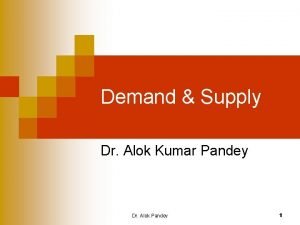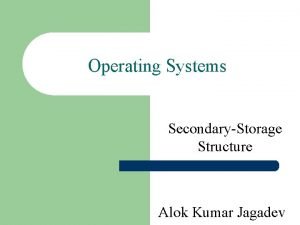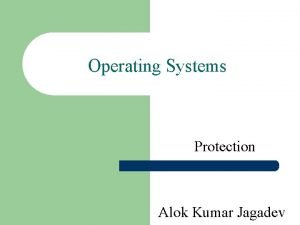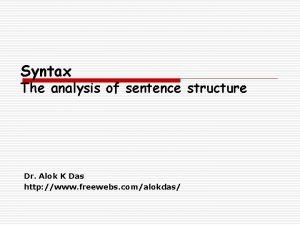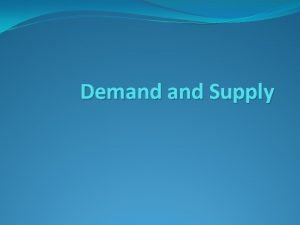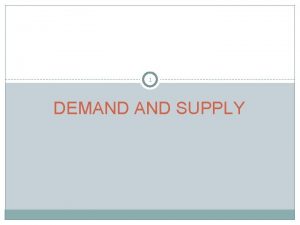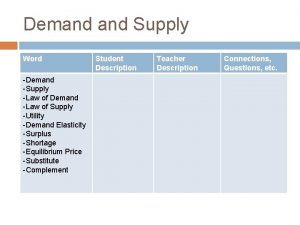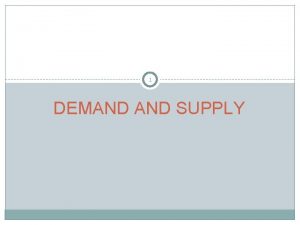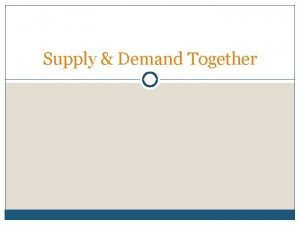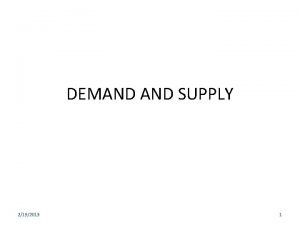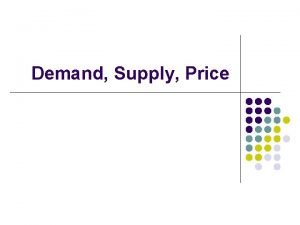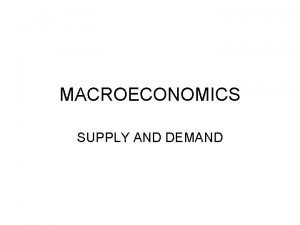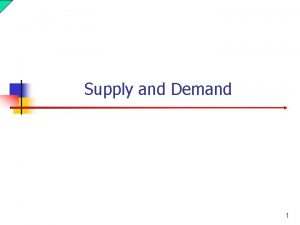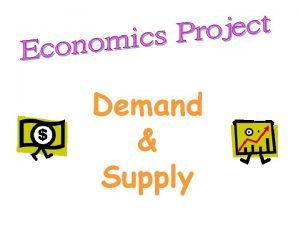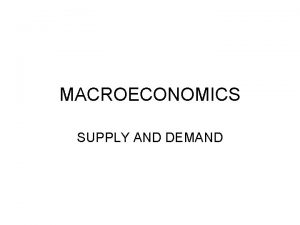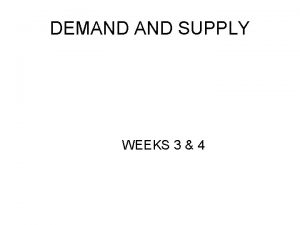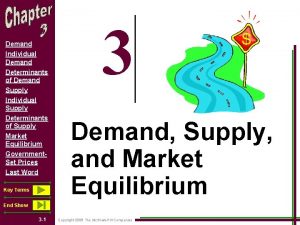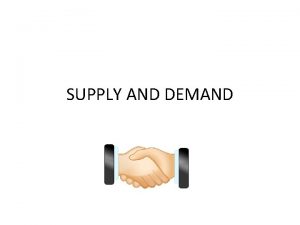Demand Supply Dr Alok Kumar Pandey Dr Alok























- Slides: 23

Demand & Supply Dr. Alok Kumar Pandey Dr. Alok Pandey 1

Agenda for Discussion n n n Income Elasticity Cross elasticity Market Demand Market Supply Bandwagon Effect Impact of Tax Price Elasticity and Tax Incidence Price Ceilings an Price Floors Dr. Alok Pandey 2

Cross-Price Elasticity of Demand n n Responsiveness of D for one good to changes in P of another good %∆ in demand for one good divided by %∆ in price of another good ¨ If positive: substitutes ¨ If negative: complements ¨ If zero: unrelated Dr. Alok Pandey 3

Market Demand Market Supply Dr. Alok Pandey 4

Bandwagon Effect Individual demand is influenced by number of other households consuming a commodity n The greater the number of households consuming a commodity n Key to marketing most toys and clothing is to create a bandwagon effect n Results in market demand curve shifting outward n Dr. Alok Pandey 5

Impact of Tax How do taxes affect the economic wellbeing of market participants? n It does not matter whether a tax on a good is levied on buyers or sellers of the good. n The price paid by buyers rises, and the price received by sellers falls. n Dr. Alok Pandey 6

The Effects of a Tax Price Supply Price buyers pay Size of tax Price without tax Price sellers receive Demand 0 Quantity with tax Quantity without tax Dr. Alok Pandey Quantity 7 Copyright © 2004 South-Western

How a Tax Affects Market Participants A tax places a wedge between the price buyers pay and the price sellers receive. n Because of this tax wedge, the quantity sold falls below the level that would be sold without a tax. n The size of the market for that good shrinks. n Dr. Alok Pandey 8

How a Tax Affects Market Participants n Tax Revenue ¨T = the size of the tax ¨ Q = the quantity of the good sold T Q = the government’s tax revenue Dr. Alok Pandey 9

Tax Revenue Price Supply Price buyers pay Size of tax (T) Tax revenue (T × Q) Price sellers receive Demand Quantity sold (Q) 0 Quantity with tax Quantity without tax Quantity 10 Dr. Alok Pandey Copyright © 2004 South-Western

How a Tax Affects Market Participants n The change in total welfare includes: ¨ The change in consumer surplus, ¨ The change in producer surplus, and ¨ The change in tax revenue. ¨ The losses to buyers and sellers exceed the revenue raised by the government. ¨ This fall in total surplus is called the deadweight loss. Dr. Alok Pandey 11

Price Elasticity and Tax Incidence n Tax ¨ Decrease n in S by the amount of tax Tax incidence ¨ Consumers : high P ¨ Producers: net-of-tax receipt Dr. Alok Pandey 12

Price Elasticity and Tax Incidence n The more price elastic the D: ¨ The more tax producers pay ¨ The less tax consumers pay n The more elastic the S: ¨ The less tax producers pay ¨ The more tax consumers pay Dr. Alok Pandey 13

Effects of price elasticity of D on tax incidence (a) Less elastic demand (b) More elastic demand 0. 20 Tax St St 1. 15 1. 00 0. 95 S 1. 05 1. 00 0. 20 Tax 0. 85 S D 0 9 10 Price D’ Millions of ounces per day 7 10 The more elastic the D curve, the more tax is paid by producers (lower net-of-tax receipt) Dr. Alok Pandey 14

Effects of price elasticity of S on tax incidence (b) Less elastic supply (a) More elastic supply 0. 20 Tax 1. 15 St” St’ S” S’ 1. 00 0. 95 1. 00 0. 20 Tax 0. 85 D’’ Price D’’ 0 8 10 quantity 9 10 The more elastic the S curve, the more tax is paid by consumers as a higher price. Dr. Alok Pandey 15

Price Ceilings n A price ceiling establishes a maximum price that sellers are legally permitted to charge. ¨ Example: n rent control When a price ceiling keeps the price of a good below the market equilibrium, there will be both direct and indirect effects. ¨ (Direct effect) A shortage: the quantity demanded will exceed the quantity supplied. Waiting lines may develop. ¨ (Indirect effects) Quality deterioration and changes in other non-price factors that are favorable to sellers & unfavorable to buyers. ¨ The quantity exchanged will fall and the gains from trade will be less than if the good were allocated by markets.

The Impact of a Price Control • Consider the rental housing market where the price (rent) P 0 would bring the quantity of rental units demanded into balance with the quantity supplied. • A price ceiling like P 1 imposes a price below market equilibrium … causing quantity demanded QD … to exceed quantity supplied QS … resulting in a shortage. • Because prices are not allowed to direct the market to equilibrium, non-price elements will become more important in determining where the scarce goods go. Price (rent) S Rental housing market P 0 Price ceiling P 1 Shortage D QS QD Quantity of housing units

Effects of Rent Control n Shortages and black markets will develop. The future supply of housing will decline. n The quality of housing will deteriorate. n Non-price methods of rationing will increase in importance. n n Inefficient use of housing will result.

Price Floor n A price floor establishes a minimum legal price for the good or service. ¨ Example: n minimum wage When a price floor keeps the price of a good above the market equilibrium, it will lead to both direct and indirect effects. ¨ (Direct effect) A surplus: sellers will want to supply a larger quantity than buyers are willing to purchase. ¨ (Indirect effects) Changes in non-price factors that are favorable to buyers and unfavorable to sellers. ¨ The quantity exchanged will fall and the gains from trade will be less than if the good were allocated by markets.

The Impact of a Price Floor Price • A price floor like P 1 imposes a price above market equilibrium … P 1 causing quantity supplied Qs … to exceed quantity demanded QD … resulting in a surplus. S Surplus Price floor P 0 • Because prices are not allowed to direct the market to equilibrium, non-price elements of exchange will become more important in determining where scarce goods go. D QD QS Quantity

Minimum Wage: An Example of a Price Floor n When the minimum wage is set above the market equilibrium for low-skill labor, the following will occur: ¨ Direct effect: n Reduces employment of low-skilled labor. ¨ Indirect effects: n Reduction in non-wage component of compensation n Less on-the-job training n May encourage students to drop out of school

Employment and the Minimum Wage Price Excess supply (wage) • Consider the market for low-skill labor where a price (wage) of 5. 00 could bring the quantity of labor demanded into balance with the quantity supplied. • A minimum wage (price floor) of 7. 25 would increase the wages of low-skill labor, but employment will decline from E 0 to E 1. • Those who lose their jobs will be pushed into either unemployment or less preferred employment. S Low-skill labor market Minimum wage level 7. 25 5. 00 D E 1 E 0 Quantity (employment)

Case Study: Does the Minimum Wage Help the Poor? n While increasing the minimum wage will increase the wages of low-skill workers, their on-the-job training opportunities, non-wage benefits, working conditions, and employment will decline. n Who earns minimum wage? ¨ Most minimum wage workers are young and / or only working part-time. ¨ Fewer than 20 percent are from families with incomes below the poverty line.
 Dr alok kumar pandey
Dr alok kumar pandey Ashok kumar pandey iit hyderabad
Ashok kumar pandey iit hyderabad Alok kumar jagadev
Alok kumar jagadev Alok kumar jagadev
Alok kumar jagadev Module 5 supply and demand introduction and demand
Module 5 supply and demand introduction and demand Matching supply with demand
Matching supply with demand Pc pandey iitb
Pc pandey iitb Sophia pandey
Sophia pandey Sophia pandey
Sophia pandey What is oosd
What is oosd Brahmi
Brahmi Omkant pandey
Omkant pandey Rishika pandey
Rishika pandey Mannu singh vs umadat pandey
Mannu singh vs umadat pandey Pc pandey iitb
Pc pandey iitb Dr nitin pandey jaipur
Dr nitin pandey jaipur Alok mohan md
Alok mohan md Alok kipo mena
Alok kipo mena Alok vijayant
Alok vijayant Alok gupta md
Alok gupta md Cache do alok
Cache do alok Dr alok adholeya
Dr alok adholeya Syntax analysis sentence structure
Syntax analysis sentence structure Deficient demand and excess demand
Deficient demand and excess demand
